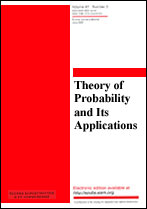|
This article is cited in 17 scientific papers (total in 17 papers)
On a two-temperature problem for Klein–Gordon equation
T. V. Dudnikovaa, A. I. Komechb
a Electrostal' Polytechnic Institute
b M. V. Lomonosov Moscow State University, Faculty of Mechanics and Mathematics
Abstract:
We consider the Klein–Gordon equation in $\mathbf{R}^n$, $n\geq 2$, with constant or variable coefficients. The initial datum is a random function with a finite mean density of the energy and satisfies a Rosenblatt- or Ibragimov–Linnik-type mixing condition. We also assume that the random function is close to different space-homogeneous processes as $x_n\to\pm\infty$, with the distributions $\mu_\pm$. We study the distribution $\mu_t$ of the random solution at time $t\in\mathbf{R}$. The main result is the convergence of $\mu_t$ to a Gaussian translation-invariant measure as $t\to\infty$ that means the central limit theorem for the Klein–Gordon equation. The proof is based on the Bernstein “room-corridor” method and oscillatory integral estimates. The application to the case of the Gibbs measures $\mu_\pm=g_\pm$ with two different temperatures $T_{\pm}$ is given. It is proved that limit mean energy current density formally is $-\infty\cdot(0,\dots,0,T_+-T_-)$ for the Gibbs measures, and it is finite and equals $-C(0,\dots,0,T_+-T_-)$ with some positive constant $C>0$ for the smoothed solution. This corresponds to the second law of thermodynamics.
Keywords:
Klein–Gordon equation, Cauchy problem, random initial data, mixing condition, Fourier transform, weak convergence of measures, Gaussian measures, covariance functions and matrices, characteristic functional.
Received: 21.10.2003
Revised: 09.05.2005
Citation:
T. V. Dudnikova, A. I. Komech, “On a two-temperature problem for Klein–Gordon equation”, Teor. Veroyatnost. i Primenen., 50:4 (2005), 675–710; Theory Probab. Appl., 50:4 (2006), 582–611
Linking options:
https://www.mathnet.ru/eng/tvp125https://doi.org/10.4213/tvp125 https://www.mathnet.ru/eng/tvp/v50/i4/p675
|


| Statistics & downloads: |
| Abstract page: | 497 | | Full-text PDF : | 180 | | References: | 81 |
|




 Contact us:
Contact us: Terms of Use
Terms of Use
 Registration to the website
Registration to the website Logotypes
Logotypes








 Citation in format
Citation in format 
